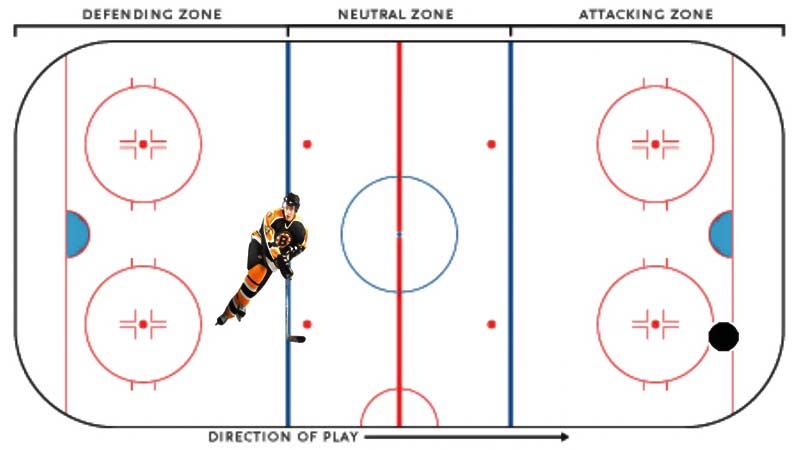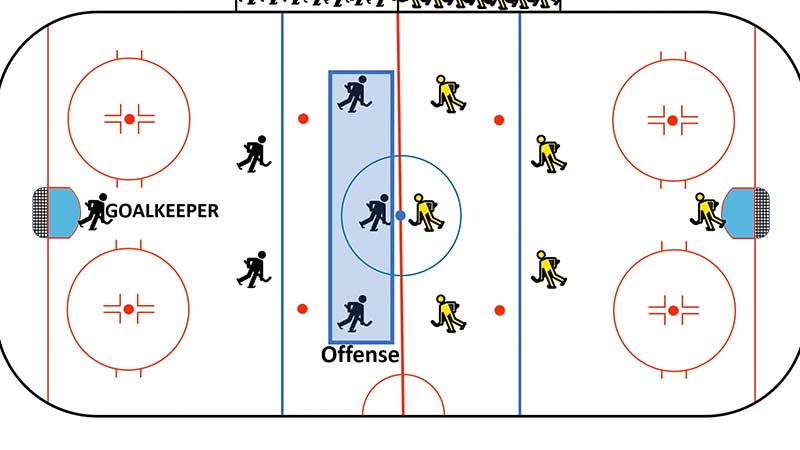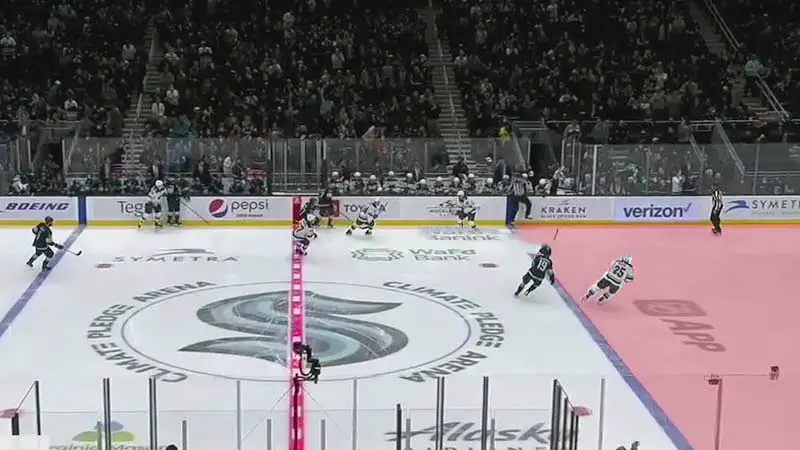In the fast-paced world of ice hockey, the red lines play a crucial role in shaping the flow of the game.
While the blue line determines offside, the center red line stands out as a key player on the rink. Serving as a marker of strategic importance, the center red line impacts gameplay through the enforcement of icing rules.
Beyond the center red line, two thinner red lines mark the boundaries of the rink, known as the goal lines.
These goal lines are instrumental in defining scoring opportunities and ensuring fair play within the confines of the ice. Together, these red lines create a dynamic playing field where players navigate the rules and tactics of the game to achieve victory.
Understanding the Red Line in Hockey
The Role of the Red Line
In ice hockey, the red line plays a pivotal role in defining crucial aspects of gameplay. It serves as the boundary where opposing teams meet as equals before play begins, ensuring a fair starting point for both sides.
The red line acts as a physical marker that divides the neutral zone, serving as a strategic element for players to maneuver across the ice. Previously, restrictions on crossing the red line were in place to regulate gameplay and limit long passes.
Historical Significance
The red line in hockey holds historical significance as it has evolved over time to shape the way the game is played. Before the 2004-2005 NHL lockout, strict rules governed crossing the red line with the puck, restricting gameplay dynamics.
However, post-lockout changes aimed to increase offensive opportunities for teams led to the legalization of two-line passes while keeping the red line intact.
Despite modifications to gameplay rules, the physical presence of the red line remains a symbolic artifact in every hockey arena worldwide, reflecting the sport’s heritage and evolution.
Rules Governing the Red Line

Icing and the Red Line
In ice hockey, one crucial aspect governed by the center red line is the rule of icing. This rule aims to prevent teams from gaining unfair advantages by excessively sending the puck to the opponent’s end.
When a player shoots the puck from behind the center red line to the other end and a defending player touches it first, icing is called, resulting in a stoppage of play.
This regulation ensures that teams cannot simply clear the puck down the ice without consequences, promoting fair gameplay and strategic puck control.
The Two-Line Pass Rule
Before its removal post-2004 NHL lockout, the two-line pass rule restricted players’ ability to pass the puck across both the center red line and the blue line in a single play.
The elimination of this rule revolutionized gameplay, allowing for more dynamic offensive strategies and faster transitions between zones.
With the red line’s continued presence on the ice, teams can still utilize strategic passing to create scoring opportunities without the constraints of the two-line pass limitation.
Other Red Line Regulations
While the center red line and the two-line pass rule have been focal points of discussions in ice hockey, additional red line regulations play vital roles in shaping gameplay.
Red line hockey, the center of the playing surface on an ice hockey rink, serves as a strategic marker for player positioning and zone control.
Furthermore, the red lines at the ends of the rink help define critical areas such as the goal lines, where scoring opportunities and defensive strategies come into play.
These regulations collectively contribute to the dynamic and strategic nature of ice hockey, showcasing the sport’s rich history and evolution on a global scale.
The Red Line’s Impact on Gameplay

Strategy and Tactics
Red lines in hockey play a crucial role in shaping teams’ strategies and tactics on the ice. The presence of the red line, specifically the center red line, enforces rules such as offside and icing, dictating how players position themselves during gameplay.
Teams strategically use the red line to control the neutral zone, creating defensive barriers that opponents must navigate.
By understanding and leveraging the red line’s regulations, teams can optimize their defensive and offensive strategies to gain a competitive edge.
Game Flow and Pacing
The red line significantly influences the flow and pacing of the game in hockey. Its presence alters how teams transition between offense and defense, affecting the speed at which plays develop on the ice.
The implementation of rules related to the red line, such as the two-line pass rule, can either speed up or slow down the pace of the game.
By considering the impact of the red line on game flow, teams can adapt their gameplay to capitalize on strategic opportunities and maintain control over the tempo of the match.
Changes and Controversy
Evolution of Red Line Rules
Red lines in ice hockey have evolved over the years, playing a crucial role in shaping the game’s dynamics.
The center red line, in particular, enforces essential rules like icing and offside, dictating player movements and team strategies.
Since the post-2004 NHL lockout era, changes allowing two-line passes while retaining the symbolic significance of the red line have transformed offensive gameplay strategies.
The red line’s influence on icing and the two-line pass rule has been pivotal in maintaining fair play and revolutionizing offensive tactics.
Debates and Adjustments in the Sport
Recent discussions among NHL general managers have revolved around reintroducing the red line to reduce concussions and injuries in the sport.
While the concept of slowing down the game to enhance player safety is noble, the effectiveness of this strategy remains uncertain.
The link between game speed, neutral zone collisions, and overall injury rates is complex, with limited data available on the direct correlation between speed and concussions.
The debate around the red line’s impact on game pace continues, emphasizing the need for thorough analysis and consideration of all factors influencing player safety in ice hockey.
Comparing International Hockey Rules
IIHF vs. NHL: Red Line Differences
In the realm of ice hockey, the International Ice Hockey Federation (IIHF) and the National Hockey League (NHL) are two prominent governing bodies with distinct sets of rules and regulations.
One significant point of differentiation between these organizations is their handling of the red line rule, which significantly impacts gameplay dynamics and strategic considerations.
NHL: Abolishment of Two-Line Pass Rule
After the 2004 lockout, the NHL implemented a significant change by removing the two-line pass rule.
This decision transformed how teams executed offensive strategies by enabling smooth long-distance passes without being restricted to crossing the center red line beforehand.
Impact on Gameplay
The removal of the two-line pass rule in the NHL has led to a dynamic style of play marked by quick transitions and seamless puck movement.
With the restriction lifted, teams have been able to utilize long passes more effectively, leading to more scoring chances and a faster pace of gameplay.
IIHF: Retention of Two-Line Pass Rule
The IIHF has chosen to retain the two-line pass rule, affirming the necessity for the puck to cross the center red line before advancing into the offensive zone.
This decision reflects a commitment to tradition, encouraging a strategic and systematic style of play.
Impact on Gameplay
The IIHF’s commitment to enforcing the two-line pass rule fosters a playing style known for its emphasis on strategic positioning and precise puck movement.
This regulation requires teams to execute accurate passes and tactical plays, placing importance on maintaining controlled possession rather than relying solely on speed.
Strategic Nuances
The differences in red line regulations between the IIHF and the NHL result in unique strategic approaches.
NHL teams focus on fast transitions and lengthy passes to generate scoring chances, while IIHF teams prioritize tactical positioning and controlled puck movement to break through the opponent’s defense.
Frequently Asked Questions
What is the center red line’s role in ice hockey?
The center red line divides the rink in half and is used for determining an offside pass. It influences gameplay by allowing or disallowing passes over that line.
How do goal lines impact player positioning?
Goal lines mark the boundaries for scoring goals. Players must maneuver around these lines strategically to create scoring opportunities and prevent opponents from scoring.
What changes did the NHL make post-2004 lockout regarding the red line?
Post-2004, the NHL removed restrictions on two-line passes, allowing players to pass over the center red line. This change altered offensive strategies while retaining the red line’s symbolic significance.
Why are there debates about reintroducing the red line for player safety?
Some NHL general managers are considering reintroducing the red line to slow down the game and decrease high-speed collisions, potentially enhancing player safety on the ice.
Conclusion
Understanding the red line’s historical and contemporary significance in ice hockey is crucial for players and fans alike. The evolution of red line rules has not only shaped gameplay strategies but also influenced the overall dynamics of matches.
With the NHL’s decision to remove the two-line pass rule, offensive tactics have become more dynamic, emphasizing speed and skill. On the other hand, the IIHF’s retention of the rule promotes a more calculated approach to gameplay.
These contrasting styles showcase how rule modifications, even as subtle as those concerning the red line, can have a profound impact on the sport.
As discussions continue regarding the red line’s role in player safety, it remains a focal point for strategic considerations in ice hockey.
Stay informed on the latest developments in red line regulations to appreciate the nuanced strategies that define the game at both professional and international levels.








James Felix